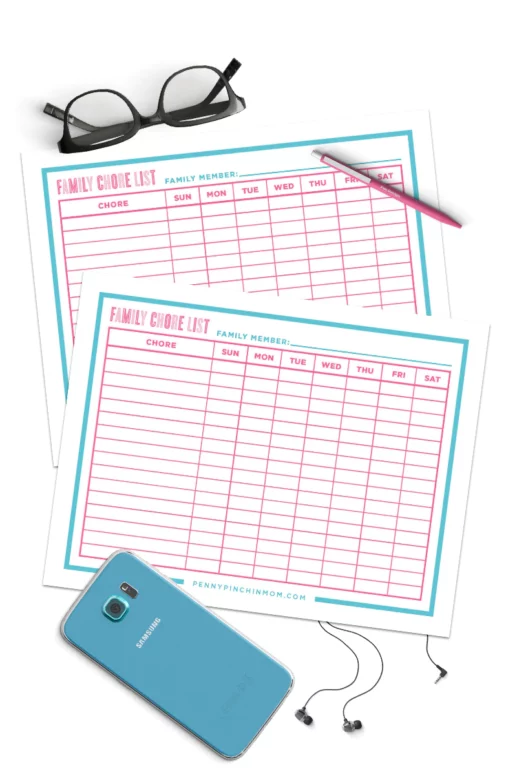Life gets busy. At times it gets so busy that it distracts us from our day-to-day to-do list. Then, you look around and everything is a mess. A literal mess.
You have clutter all over your dining room table.
The laundry hasn’t been sorted in three weeks (#trueconfessions) and you are afraid to look at that questionable Tupperware in the back of your fridge.
I totally get it, no judgment on this end.
I’ve been there and understand the dread of tackling that mess on your precious Saturday. This is precisely what made me rethink my chore list process.
I’m a full-time working wife and mom of two girls. As if that weren’t enough, I also run a blog called The Frugal Convert. So, my days start at 4 a.m. and end at 9 or 10 p.m. I’m usually sleep-deprived and running on empty.
So, I had to adopt a system that would help me organize my life while giving me TIME to do the things that mattered. No one wants to spend every waking moment tackling a chore chart day in and day out, so here is how I do it.
1. Make a list of the important chores
It’s important that you’re realistic with your chore chart. So many people look at the ideal scenario when they plan out their tasks. But the best way to get things done is to give priority to the chores that make your life easier. So, tackling the gardening on a week where you’re running from soccer practice to the recital to the birthday party is probably not a great idea.
Download my free Family Chore Chart Printable
2. Enlist the family
I know you want everything to be done PERFECTLY, but I promise, done is good enough. Many of us (myself included) are perfectionists when it comes to how we like things done around the house.
But, if the counter is decluttered and wiped down, it’s going to look 10 times better than a cluttered counter that’s waiting for your undivided attention to declutter, wipe down, and buff into an Instagram-worthy sparkle.
Enlisting help with the chores will help you check off your list MUCH faster and with less energy from you. It also teaches your kids responsibility and ownership of those tasks, a life skill every kid should learn. (And chores can be tied to whether your kid gets an allowance.)
3. Use the 80/20 rule
This is also known as the Pareto principle, which basically says that 80% of the results are affected by 20% of your actions. So, in order words, you need to find the small habits or tasks you can do that make the biggest impact on your week.
So, meal prep an hour on Sunday to save three hours during the week. Take 15 seconds to wipe down the bathroom sink after every use and keep it looking clean longer.
Small steps often make the biggest impact. Find the small steps you can take every day that will help you shave off hours of time and energy from your week.
4. Assess each person’s ability
We’ll assume that your partner or spouse can do ANY of the things you do. So, we’ll jump right into assessing the kids.
Based on your child’s age, they can do many chores around the house.
Here is a list with some ideas of what your child can do based on their age:
You’ll notice that the list starts with age 2! It’s incredible what our little ones are capable of doing.
5. Use the KISS method
The Keep It Simple Stupid (KISS) method is a great way to simplify chores for your family.
Creating a chore chart for each child is quick and helps them SEE what they’re responsible for. If they’re young and can’t read yet or respond better to pictures, add graphics and pictures to help them engage with their chore chart.
Perhaps laminate it and allow them to add stickers for every day they finish their chores.
For adults or grown kids in your family, Trello is a great option to stay organized. Your family can digitally check off their completed chores and it’s easy for you to keep track of the chore chart on your phone.
Easy peasy.
6. Incentivize the chore chart
Incentives can be a wonderful thing. It’s a great way to encourage help from your family.
For the younger kids, they can get an extra 30 minutes on the iPad if they reach a certain number of chores done in a week, or an ice cream at the end of the week, or some money to spend at the Dollar Tree toy section. For your older kids, they can earn extra allowance or some time past their normal curfew for EXTRA chores completed.
It’s about making life easier
Chore charts don’t have to be a daunting list of to-dos. Keeping your chart realistic and enlisting help will make completing your chores so much easier. It’s a relatively simple thing to do that pays off extremely well.
—By Gina Zakaria
